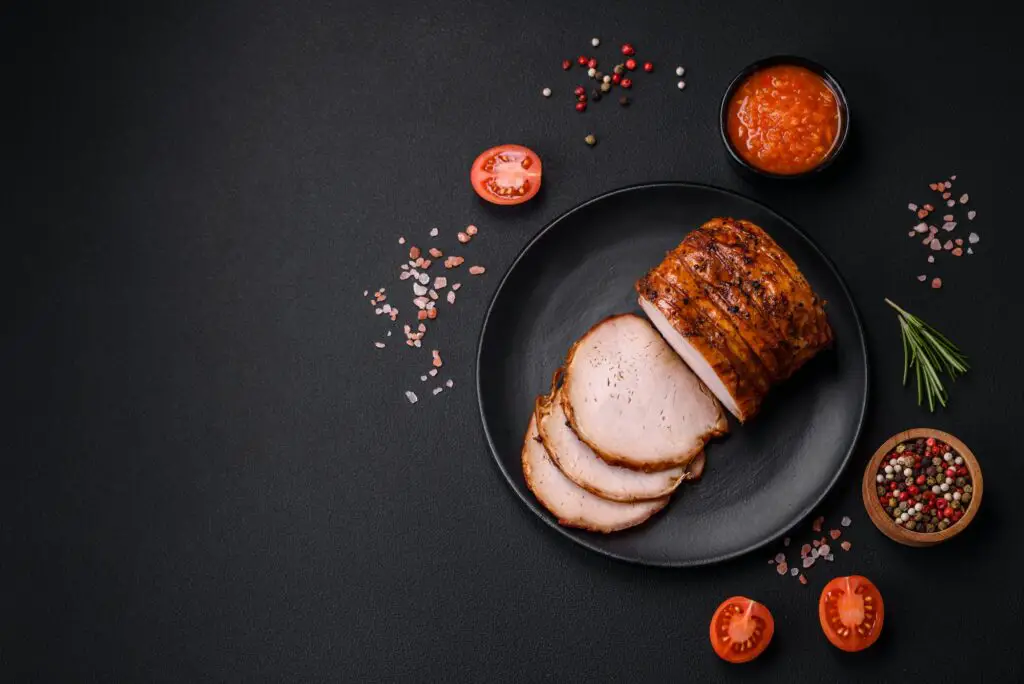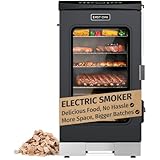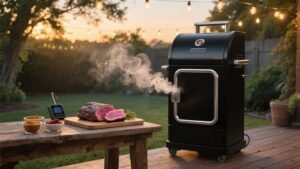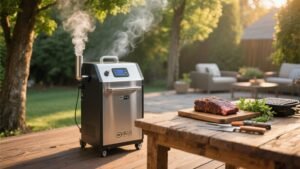Are you tired of spending a fortune on store-bought smoked meats? Do you crave the mouthwatering flavors and succulent textures that only come from slow-cooked, homemade barbecue? Well, my friend, it’s time to take matters into your own hands and embark on an exciting journey of creating your very own DIY electric smoker.
Imagine the satisfaction of crafting your own smoking apparatus, tailored to your specific needs and preferences. With just a few essential tools and some basic materials, you can transform ordinary cuts of meat into delectable masterpieces bursting with smoky goodness.
In this article, we will guide you through the process of building your DIY electric smoker from start to finish. From understanding the fundamentals of smoking meat to troubleshooting common issues, we’ve got you covered.
So roll up your sleeves, gather your supplies, and get ready to become the pitmaster extraordinaire in your neighborhood!
Table of Contents
ToggleUnderstanding the Basics of Smoking Meat
To get started with smoking meat, you’ll need to understand the basics of how it works and what equipment you’ll need. Smoking meat is a cooking technique that involves using low heat and smoke to slowly cook and flavor your meat. The process infuses the meat with a rich smoky flavor and helps to tenderize it at the same time.

There are different techniques for smoking meat, but the basic principle remains the same. You’ll need a smoker, which can be either electric, gas, or charcoal-powered. Electric smokers are popular because they offer precise temperature control and are relatively easy to use.
When smoking meat, it’s important to choose the right type of wood chips or chunks for your desired flavor. Different types of wood impart different flavors to your meat, so experiment with different varieties like hickory, mesquite, or applewood.
The benefits of smoking meat go beyond just taste. Smoking helps preserve food by inhibiting bacterial growth through the smoke’s antimicrobial properties. Additionally, it can help reduce the formation of potentially harmful compounds that can occur during other cooking methods like grilling.
Now that you understand the basics of smoking meat and have an idea about the equipment needed, you’re ready to dive into this delicious cooking technique!
Gathering the Necessary Tools and Materials
First, gather all the tools and materials you’ll need for this project, such as a drill, pliers, and a metal cutting saw. Did you know that on average, it takes about 4 hours to complete gathering everything needed for building an electric smoker?
When choosing the right tools and materials for your DIY electric smoker, it’s important to consider their quality and durability. Look for tools that are specifically designed for working with metal and electrical components. For example, a drill with variable speed settings will allow you to control the drilling process more effectively. Pliers with insulated handles will help protect you from any potential electrical shocks.
When it comes to sourcing affordable materials for your electric smoker project, there are a few tips to keep in mind. Consider checking out local hardware stores or online marketplaces where you can find discounted or second-hand items. You can also repurpose old appliances or scrap metal to save money. Additionally, reaching out to friends or family members who may have spare materials can be a great way to acquire what you need without breaking the bank.
By carefully selecting the right tools and finding affordable materials, you’ll be well on your way to successfully building your own DIY electric smoker.
Choosing the Right Design for Your Electric Smoker
When selecting the perfect design for your homemade smoking contraption, let your creativity run wild and envision a smoker that not only cooks delicious meats but also adds a touch of personality to your backyard cooking experience. Consider the following factors when choosing the right design for your electric smoker:
Size: Determine how much space you have available in your backyard and how much food you plan to smoke at once. This will help you decide on the appropriate size of your smoker.
Insulation: Look for designs that prioritize insulation to ensure consistent temperatures during smoking. This will help maintain the flavor and tenderness of your meats.
Airflow Control: Opt for designs that offer control over airflow, as this is crucial for maintaining the ideal smoking conditions. You should be able to adjust vents or dampers to regulate temperature and smoke levels.
Consider these tips when using your electric smoker:
Maintenance: Regularly clean and inspect your electric smoker to ensure it remains in good working condition. Clean out any ash or residue after each use, and check for any damaged parts that may need replacing.
Smoking Different Meats: Each type of meat requires different smoking times and temperatures. Research specific guidelines or recipes for smoking different cuts so you can achieve optimal results every time.
Remember, with the right design and proper maintenance, your DIY electric smoker can become a reliable tool for creating mouthwatering smoked dishes in your own backyard.
Building the Smoker’s Frame and Structure
Let your creativity ignite and construct the sturdy foundation of your smoking masterpiece, crafting a structure that embodies the essence of your backyard cooking dreams.
When it comes to building the frame and structure for your DIY electric smoker, there are a few key building techniques you should keep in mind.
First, choose the material for your smoker’s frame. Many DIY enthusiasts opt for materials like steel or aluminum due to their durability and heat resistance. Ensure that the chosen material is strong enough to support the weight of the smoker components and can withstand high temperatures.
Next, plan out the dimensions and layout of your smoker. Take into consideration factors such as available space, airflow requirements, and accessibility for maintenance purposes. This will help you determine how many shelves or racks you’ll need to accommodate different types of food.
As you begin assembling the frame, make sure to follow proper safety precautions. Wear protective gear such as gloves and goggles when cutting or welding metal parts. Secure all connections tightly using screws or bolts to ensure stability.
Lastly, consider adding additional features such as wheels or handles for easy maneuverability. These can be especially useful if you plan on moving your electric smoker around frequently.
By applying these building techniques and following safety precautions, you’ll be well on your way to creating a sturdy and functional structure for your DIY electric smoker.
Installing the Electrical Components
Get ready to bring your smoking masterpiece to life by installing the essential electrical components that’ll make your backyard cooking dreams a reality. When it comes to choosing the right wiring system for your DIY electric smoker, safety should be your top priority. Make sure to select high-quality wires that are rated for outdoor use and can handle the power requirements of your smoker.
It’s also important to properly insulate and protect the wires from any potential damage. Another crucial aspect is ensuring proper ventilation in your smoker. Good airflow is essential for maintaining consistent temperature and preventing overheating. Consider installing vents or fans that can help regulate the airflow inside the smoker. These components won’t only improve the cooking performance but also extend the lifespan of your equipment.
When installing electrical components, follow all manufacturer instructions carefully and consult an electrician if needed. Double-check all connections and make sure everything is securely fastened before powering up your smoker. Safety should always come first when working with electricity.
By choosing the right wiring system and ensuring proper ventilation, you’re taking important steps towards creating a safe and efficient DIY electric smoker that’ll deliver mouthwatering results every time you fire it up.
Creating the Smoker Box for Wood Chips
To enhance the smoky flavor in your backyard masterpiece, you’ll need to construct a box specifically designed for holding and burning wood chips.
Here are four wood chip options that will take your smoking techniques to the next level:
- Mesquite: This strong and bold-flavored wood chip is perfect for adding a rich taste to beef, pork, or game meats. Its intense smokiness pairs well with hearty flavors.
Apple: If you prefer a milder smoke, apple wood chips are an excellent choice. They provide a subtle sweetness that complements poultry and pork dishes exceptionally well.
Hickory: Known for its robust flavor profile, hickory wood chips add a deep and savory taste to any meat you’re smoking. It’s particularly popular with ribs and briskets.
Cherry: For those looking to add a touch of fruity sweetness to their smoked dishes, cherry wood chips are ideal. They offer a delicate and mild smoke that pairs perfectly with chicken and fish.
When choosing your wood chip option, consider the type of protein you’re smoking and the intensity of flavor you desire. Experimenting with different combinations will allow you to find your signature smoky taste!
Adding Temperature Control Features
Ensure your backyard masterpiece is cooked to perfection by incorporating temperature control features that’ll give you the power to manipulate the heat and create a symphony of flavors.
When it comes to smoking meat, maintaining a consistent temperature is key. Luckily, there are several temperature control techniques you can use for your DIY electric smoker.
One popular option is to use a DIY temperature controller. This device allows you to monitor and adjust the temperature inside your smoker without constantly checking on it. You can either build your own using an Arduino or Raspberry Pi or purchase a pre-made controller online. These controllers typically come with temperature probes that can be inserted into the meat, allowing you to monitor its internal temperature as well.
Another technique is to use vents or dampers on your smoker. By opening or closing these vents, you can increase or decrease airflow, which in turn affects the temperature inside the smoker. It’s important to note that this method requires more manual monitoring and adjustment compared to a temperature controller.
Whichever method you choose, make sure to do thorough research and follow safety precautions when adding temperature control features to your DIY electric smoker. With precise control over the heat, you’ll be able to achieve mouthwatering results every time you fire up your backyard barbecue.
Insulating and Sealing the Smoker
One way to improve the efficiency of your backyard masterpiece is by insulating and sealing it, creating a tight and well-protected cooking environment.
Insulating techniques can help retain heat and maintain a consistent temperature inside the smoker. One popular method is using ceramic insulation, which provides excellent heat retention and helps prevent any heat loss. Another option is using fiberglass insulation, which is affordable and readily available at most hardware stores. It’s important to properly install the insulation by lining the interior walls of the smoker with it.
Sealing materials are also crucial in preventing any smoke or heat from escaping. High-temperature silicone gaskets are commonly used to create an airtight seal between the door and body of the smoker. These gaskets can withstand high temperatures without deteriorating, ensuring that no smoke or heat leaks out during the smoking process.
In addition to gaskets, you can use high-temperature caulk to seal any gaps or cracks in the smoker’s joints or seams. This will further enhance its ability to maintain a consistent temperature throughout the cooking process.
By implementing these insulating techniques and using proper sealing materials, you can optimize your DIY electric smoker’s performance and create delicious smoked dishes with minimal heat loss or fluctuations in temperature.
Testing and Adjusting the Smoker’s Performance
Now it’s time to put your backyard masterpiece to the test and fine-tune its performance for optimal smoking perfection. Here are a few things you can do to make sure your DIY electric smoker is working at its best:
Adjusting Ventilation:
- Open or close the vents: Experiment with different vent positions to control the airflow within the smoker. This will help regulate temperature and smoke circulation.
- Monitor smoke production: Keep an eye on how much smoke is being produced. Adjusting the vents can help achieve that perfect balance between too little and too much smoke.
Testing Temperature Accuracy:
- Use a reliable thermometer: Place a thermometer inside the smoker, away from direct heat sources, to accurately measure the internal temperature.
- Compare readings: Check if the temperature displayed on your smoker matches that of your external thermometer. If there’s a significant difference, you may need to recalibrate or adjust your smoker’s thermostat.
Fine-tuning:
- Make small adjustments: Once you have tested and compared temperatures, make minor adjustments to find that sweet spot where your desired smoking temperature is consistently maintained.
- Keep notes: Document any changes made during testing so you can replicate successful results in future smoking sessions.
By adjusting ventilation and testing temperature accuracy, you can ensure that your DIY electric smoker performs optimally, allowing you to create delicious smoked dishes with confidence.
Seasoning Your Electric Smoker
To truly elevate your smoking game, get ready to tantalize your taste buds by seasoning your trusty smoke machine. Seasoning is an essential step in preparing your electric smoker for its first use. It helps remove any manufacturing residues and imparts a layer of flavor that will enhance the taste of your future smoked dishes.
Before you start, make sure to clean the interior of your smoker thoroughly. Remove any dust or debris that may have accumulated during storage. Once clean, preheat the smoker to around 275 degrees Fahrenheit for about three hours. This’ll help burn off any remaining oils or chemicals from the manufacturing process.
While seasoning, you can troubleshoot common problems such as temperature inconsistencies or uneven heating. Pay attention to how well the heat is distributed throughout the smoker and adjust accordingly if needed. This’ll ensure that every part of your food receives equal amounts of heat and smoke.
To achieve the best flavor, consider adding wood chips or chunks during the seasoning process. Experiment with different types of wood like hickory or applewood to find your preferred taste profile.
Once seasoned, your electric smoker’s ready for action! Remember these tips for achieving the best flavor: maintain a consistent temperature throughout the smoking process, use high-quality ingredients, and be patient – good things come to those who wait! Happy smoking!
Preparing and Smoking Your First Batch of Meat
Before you dive into preparing and smoking your first batch of meat, it’s important to gather all the necessary ingredients and tools. Start by choosing the right cuts of meat for smoking. Some popular choices include brisket, ribs, pork shoulder, and chicken. These cuts are known for their ability to absorb smoke flavors and become tender and juicy when cooked low and slow.
Next, make sure you have a good quality dry rub or marinade to enhance the flavor of your meat. You can find various recipes online or create your own using a combination of spices like paprika, brown sugar, garlic powder, salt, and pepper.
When it comes to achieving the perfect smoke flavor, there are a few tips to keep in mind. First, soak wood chips in water for at least 30 minutes before adding them to your smoker. This’ll help produce more smoke during the cooking process. Additionally, maintain a consistent temperature throughout the smoking process by regularly monitoring your smoker’s thermometer.
Be patient! Smoking meat takes time but it’s well worth the wait. Allow enough time for your chosen cut of meat to cook slowly until it reaches its desired internal temperature.
By following these tips and techniques, you’ll be well on your way to enjoying delicious smoked meats from your DIY electric smoker!
Maintaining and Cleaning Your Electric Smoker
To keep your smoker in top condition and ensure delicious results, it’s important to properly maintain and clean it regularly. Here are three essential tips for maintaining and cleaning your electric smoker:
Clean the Interior: Start by unplugging the smoker and allowing it to cool down completely. Remove any leftover ashes or debris from the interior using a brush or vacuum cleaner. For stubborn residue, use a mixture of warm water and mild dish soap to scrub the surfaces gently. Avoid using abrasive cleaners that can damage the smoker.
Prevent Rust: As electric smokers are often exposed to moisture during cooking, it’s crucial to prevent rust from forming on its metal parts. After cleaning, make sure to dry the interior thoroughly with a cloth or towel. Applying a thin layer of vegetable oil on the metal surfaces will create a protective barrier against rust.
Maintain the Exterior: Wipe down the exterior of your electric smoker with a damp cloth regularly to remove any grease or dirt buildup. Avoid using harsh chemicals that could damage the finish of your appliance.
By following these cleaning techniques and taking preventive measures against rust, you can extend the lifespan of your electric smoker while ensuring optimal performance for years to come!
Troubleshooting Common Issues
If your electric smoker is experiencing any issues, troubleshooting common problems can help you quickly get back to enjoying perfectly smoked meals.
When it comes to heating issues, start by checking the power source and ensuring that the smoker is plugged in properly. If the smoker still doesn’t heat up, inspect the heating element for any signs of damage or wear. Sometimes a faulty thermostat can be the culprit, so make sure it’s set to the desired temperature and functioning correctly.
When troubleshooting smoke production, first check if there is enough wood chips or pellets in the smoker. Insufficient fuel can result in weak or no smoke production. Additionally, ensure that the ventilation openings are not blocked as this could prevent proper airflow and affect smoke generation.
Another common issue is uneven heat distribution. To address this problem, try rearranging your food items inside the smoker to promote even cooking. You can also use a digital thermometer to monitor temperature variations at different spots within the smoker.
Troubleshooting heating issues involves checking power sources, inspecting heating elements and thermostats. Troubleshooting smoke production includes ensuring sufficient fuel and unobstructed ventilation openings. Lastly, addressing uneven heat distribution requires adjusting food placement and monitoring temperatures throughout the smoker.
By following these steps, you’ll be able to resolve many common issues with your electric smoker and continue enjoying delicious smoked meals with ease!
Upgrading and Customizing Your Electric Smoker
Enhance your smoking experience by personalizing and upgrading your electric smoker to suit your unique taste and preferences. Upgrading techniques and smoker customization ideas can take your DIY electric smoker to the next level. Here are some tips to help you get started:
| Upgrading Techniques | Smoker Customization Ideas |
|---|---|
| Install a Temperature Control System | Add a Personalized Design or Logo |
| Upgrade the Heating Element for Better Performance | Customize the Size or Shape of the Smoker |
| Install Additional Racks for More Cooking Space | Incorporate Built-in Thermometers for Accurate Temperature Monitoring |
| Add Insulation to Improve Heat Retention | Personalize the Control Panel with Easy-to-Read Labels |
By installing a temperature control system, you can easily regulate the heat inside your electric smoker, ensuring consistent results every time. Upgrading the heating element will improve performance and provide more even heat distribution. Adding extra racks allows you to cook larger quantities of food or different types simultaneously.
Customizing your electric smoker’s appearance is another way to make it stand out. You can incorporate a personalized design or logo on its exterior, making it unique to you. Additionally, customizing the size or shape of the smoker can cater specifically to your needs.
Don’t forget about functionality! Installing built-in thermometers helps monitor temperatures accurately, while insulation improves heat retention, reducing energy consumption.
With these upgrading techniques and customization ideas, you can create an electric smoker that not only produces delicious smoked foods but also reflects your style and preferences.
Frequently Asked Questions
How can I prevent my electric smoker from overheating?
To prevent your electric smoker from overheating and maintain a consistent temperature, make sure to properly insulate it, use a thermometer to monitor the heat, adjust the vents for airflow control, and avoid overcrowding the smoker with too much food.
What are some common mistakes to avoid when using a DIY electric smoker?
To avoid common mistakes when using an electric smoker, make sure to master temperature control. Don’t let it go up in smoke by neglecting to monitor and adjust the heat properly.
Can I use a DIY electric smoker for cold smoking?
Yes, you can use a DIY electric smoker for cold smoking. Cold smoking techniques involve smoking food at low temperatures to enhance flavor without cooking it. The benefits of cold smoking include preserving food and creating unique flavors.
How do I ensure even heat distribution in my DIY electric smoker?
To ensure even heat distribution in your homemade electric smoker, focus on building a well-insulated chamber with proper ventilation. Use materials like ceramic tiles or fire bricks to retain and distribute heat evenly. Control the temperature with a thermostat or adjustable heating element.
What are some alternative fuel options for a DIY electric smoker?
To achieve different smoke flavors and enhance temperature control in your DIY electric smoker, consider using alternative fuels like wood chips, pellets, or even charcoal. These options can add a unique taste to your dishes while allowing precise heat regulation.
Conclusion
Congratulations! You now possess the knowledge and skills to create your very own DIY electric smoker. With a little creativity and determination, you can enjoy perfectly smoked meats right in your backyard.
So go ahead, impress your friends and family with your homemade culinary masterpiece. Just remember, when it comes to smoking meat, the only limit is your imagination.
Happy smoking!







